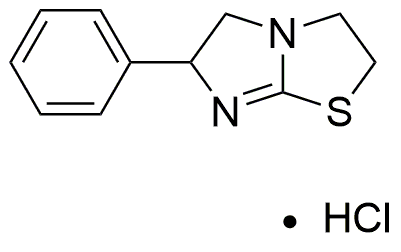Tetramisole hydrochloride is widely utilized in research focused on:
- Veterinary Medicine: Commonly used as an anthelmintic agent to treat parasitic infections in livestock, improving animal health and productivity.
- Pharmaceutical Development: Investigated for its immunomodulatory properties, it has potential applications in developing treatments for autoimmune diseases.
- Research on Cancer: Studies indicate that it may enhance the effectiveness of certain chemotherapy drugs, providing a complementary approach in cancer treatment.
- Agricultural Applications: Employed in crop protection as a pesticide, helping to manage nematode infestations and improve crop yields.
- Analytical Chemistry: Used in various assays to detect and quantify specific compounds, aiding researchers in environmental and food safety studies.
Informations générales
Propriétés
Sécurité et réglementation
Applications
Tetramisole hydrochloride is widely utilized in research focused on:
- Veterinary Medicine: Commonly used as an anthelmintic agent to treat parasitic infections in livestock, improving animal health and productivity.
- Pharmaceutical Development: Investigated for its immunomodulatory properties, it has potential applications in developing treatments for autoimmune diseases.
- Research on Cancer: Studies indicate that it may enhance the effectiveness of certain chemotherapy drugs, providing a complementary approach in cancer treatment.
- Agricultural Applications: Employed in crop protection as a pesticide, helping to manage nematode infestations and improve crop yields.
- Analytical Chemistry: Used in various assays to detect and quantify specific compounds, aiding researchers in environmental and food safety studies.
Documents
Fiches de données de sécurité (FDS)
La FDS fournit des informations de sécurité complètes sur la manipulation, le stockage et l’élimination du produit.
Spécifications du produit (PS)
Le PS fournit une description complète des propriétés du produit, notamment sa composition chimique, son état physique, sa pureté et les exigences de stockage. Il détaille également les plages de qualité acceptables et les applications prévues du produit.
Certificats d'analyse (COA)
Recherchez des certificats d'analyse (COA) en saisissant le numéro de lot du produit. Les numéros de lot et de lot se trouvent sur l'étiquette d'un produit, après les mots « Lot » ou « Lot de fabrication ».
Numéro de catalogue
Numéro de lot/série
Certificats d'origine (COO)
Ce certificat d'exploitation confirme le pays dans lequel le produit a été fabriqué, et détaille également les matériaux et composants utilisés et s'il est issu de sources naturelles, synthétiques ou autres sources spécifiques. Ce certificat peut être requis pour les douanes, le commerce et la conformité réglementaire.
Numéro de catalogue
Numéro de lot/série
Fiches de données de sécurité (FDS)
La FDS fournit des informations de sécurité complètes sur la manipulation, le stockage et l’élimination du produit.
DownloadSpécifications du produit (PS)
Le PS fournit une description complète des propriétés du produit, notamment sa composition chimique, son état physique, sa pureté et les exigences de stockage. Il détaille également les plages de qualité acceptables et les applications prévues du produit.
DownloadCertificats d'analyse (COA)
Recherchez des certificats d'analyse (COA) en saisissant le numéro de lot du produit. Les numéros de lot et de lot se trouvent sur l'étiquette d'un produit, après les mots « Lot » ou « Lot de fabrication ».
Numéro de catalogue
Numéro de lot/série
Certificats d'origine (COO)
Ce certificat d'exploitation confirme le pays dans lequel le produit a été fabriqué, et détaille également les matériaux et composants utilisés et s'il est issu de sources naturelles, synthétiques ou autres sources spécifiques. Ce certificat peut être requis pour les douanes, le commerce et la conformité réglementaire.


